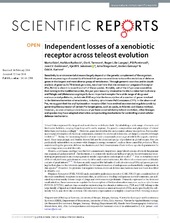| dc.contributor.author | Eide, Marta | |
| dc.contributor.author | Rydbeck, Halfdan | |
| dc.contributor.author | Tørresen, Ole K. | |
| dc.contributor.author | Lille-Langøy, Roger | |
| dc.contributor.author | Puntervoll, Pål | |
| dc.contributor.author | Goldstone, Jared V. | |
| dc.contributor.author | Jakobsen, Kjetill Sigurd | |
| dc.contributor.author | Stegeman, John | |
| dc.contributor.author | Goksøyr, Anders | |
| dc.contributor.author | Karlsen, Odd Andre | |
| dc.date.accessioned | 2019-04-26T11:20:16Z | |
| dc.date.available | 2019-04-26T11:20:16Z | |
| dc.date.issued | 2018-07-10 | |
| dc.Published | Eide M, Rydbeck H, Tørresen OK, Lille-Langøy R, Puntervoll P, Goldstone JV, Jakobsen KS, Stegeman J, Goksøyr A, Karlsen OA. Independent losses of a xenobiotic receptor across teleost evolution. Scientific Reports. 2018;8:10404 | eng |
| dc.identifier.issn | 2045-2322 | en_US |
| dc.identifier.uri | http://hdl.handle.net/1956/19411 | |
| dc.description.abstract | Sensitivity to environmental stressors largely depend on the genetic complement of the organism. Recent sequencing and assembly of teleost fish genomes enable us to trace the evolution of defense genes in the largest and most diverse group of vertebrates. Through genomic searches and in-depth analysis of gene loci in 76 teleost genomes, we show here that the xenosensor pregnane X receptor (Pxr, Nr1i2) is absent in more than half of these species. Notably, out of the 27 genome assemblies that belong to the Gadiformes order, the pxr gene was only retained in the Merluccidae family (hakes) and Pelagic cod (Melanonus zugmayeri). As an important receptor for a wide range of drugs and environmental pollutants, vertebrate PXR regulate the transcription of a number of genes involved in the biotransformation of xenobiotics, including cytochrome P450 enzymes (CYP). In the absence of Pxr, we suggest that the aryl hydrocarbon receptor (Ahr) have evolved an extended regulatory role by governing the expression of certain Pxr target genes, such as cyp3a, in Atlantic cod (Gadus morhua). However, as several independent losses of pxr have occurred during teleost evolution, other lineages and species may have adapted alternative compensating mechanisms for controlling crucial cellular defense mechanisms. | en_US |
| dc.language.iso | eng | eng |
| dc.publisher | Springer Nature | en_US |
| dc.rights | Attribution CC BY | eng |
| dc.rights.uri | http://creativecommons.org/licenses/by/4.0 | eng |
| dc.title | Independent losses of a xenobiotic receptor across teleost evolution | en_US |
| dc.type | Peer reviewed | |
| dc.type | Journal article | |
| dc.date.updated | 2018-08-19T15:31:34Z | |
| dc.description.version | publishedVersion | en_US |
| dc.rights.holder | Copyright 2018 The Author(s) | en_US |
| dc.identifier.doi | https://doi.org/10.1038/s41598-018-28498-4 | |
| dc.identifier.cristin | 1602998 | |
| dc.source.journal | Scientific Reports | |

